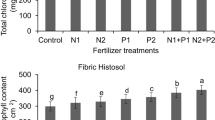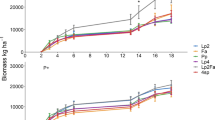Summary
The effects ofLupinus angustifolius, L. arboreus. and nitrogen fertilizer plus weedicide on soil inorganic nitrogen, and the growth, nutrition and water status ofPinus radiata seedlings were compared on a sandy podzol in Victoria Australia. Both lupins increased the concentration of soil inorganic nitrogen from 6 μg g−1 to at least 11 μg g−1 one year after treatment.Lupinus arboreus (a perennial) led to high mortality ofP. radiata seedlings and no growth response in survivors because it competed for water during summer. In contrast,L. angustifolius (an annual) senesced prior to summer and resulted in increased fascicle size and stem growth rates ofP. radiata. Growth ofP. radiata withL. angustifolius was similar to that with weedicide only. The concentration. of phosphorus in foliage ofP. radiata seedlings was highest when growth withL. angustifolius. However, the highest growth rate ofP. radiata occurred in the nitrogen fertilizer plus weedicide treatment.
Similar content being viewed by others
References
Batini F E and Anderson G W 1980 Agroforestry under 13 to 18 year oldPinus radiata, Wellbucket, Western Australia.In Managing Nitrogen Economies of Natural and Man Made Forest Ecosystems. Eds. R A Rummery and F A Hingston. CSIRO Div. Land Resources Management, Perth, Western Australia, pp 346–353.
Bremner J M 1965 Inorganic forms of nitrogen.In Methods of Soil Analysis Part 2. Ed. C A Black. pp 1179–1237. American Soc. Agron, Wisconsin, USA.
Crane W J E 1981 Growth following fertilization of thinnedPinus radiata stands near Canberra in south-eastern Australia. Aust. For. 44, 14–25.
Flinn D W et al. 1979 Nutrient loss from the burning ofPinus radiata logging residue. Aust. For. Res. 9, 17–23.
Gadgil R L 1971 The nutritional role ofLupinus arboreus in coastal sand dune forestry. 3. Nitrogen distribution in the ecosystem before tree planting. Plant and Soil 35, 113–126.
Gadgil R L 1979 The nutritional role ofLupinus arboreus in coastal sand dune forestry. 4. Nitrogen distribution in the ecosystem for the first 5 years after tree planting. N.Z.J. For. Sci. 9, 324–336.
Gardner W K and Boundy K A 1983 The acquisition of phosphorus byLupinus albus L. IV. The effect of interplanting wheat and white lupin on the growth and mineral composition of the two species. Plant and Soil 70, 391–402.
Nambiar E K S and Nethercott K H 1981 Nitrogen supply to radiata pine through legumes.In Proceedings Australian Forest Nutrition Workshop Productivity in Perpetuity, CSIRO, Melbourne, p 330.
Raison R J et al. 1982 Effects of intensified harvesting on rates of nitrogen and phosphorus removal fromPinus radiata and Eucalyptus forests in Australia and New Zealand. N.Z. J. For. Sci. 12, 394–403.
Richards B N and Bevege D I 1967 The productivity and nitrogen economy of artificial ecosystems comprising various combinations of perennial legumes and coniferous tree species. Aust J. Bot. 15, 467–480.
Rook D Aet al. 1976 Reaction of radiata pine to drought.In Proceedings Soil and Water Symposium, Palmerston North, New Zealand, pp 55–68.
Scholander P F et al. 1965 Sap pressure in vascular plants. Science, N.Y., 148, 339–346.
Sheriff D W and Whitehead D 1984 Photosynthesis and wood structure inPinus radiata D. Don during dehydration and immediately after rewatering. Plant, Cell, Environ. 7, 53–62.
Swaby R J and Sherber J 1958 Phosphate-dissolving micro-organisms in the rhizosphere of legumes.In Nutrition of the Legumes. Ed. E G Hallsworth. Butterworths Scientific, London, pp 289–294.
Turvey N D and Smethurst P J 1983 Nitrogen fixing plants in forest plantation management.In Biological Nitrogen Fixation in Forest Ecosystems: Foundations and Applications. Eds. J C Gordon and C T Wheeler. Martinus Nijhoff/Dr W Junk, The Hague. pp 233–259.
Walkley A 1947 A critical examination of a rapid method for determining organic carbon in soils. Soil Sci. 63, 251–264.
Waring H D 1966 The nitrogen balance and soil fertility in pine plantations.In Proceedings of Australian Soil Science Conference, Brisbane, Queensland, pp 5, 12–14.
Waring S A and Bremner J M 1964 Ammonium production in soil under waterlogged conditions as an index of nitrogen availability. Nature 201, 951–952.
Whitehead D C 1981 An improved chemical extraction method for predicting the supply of available soil nitrogen. J. Sci. Food Agric. 32, 359–365.
Woods R V 1976 Early silviculture for upgrading productivity on marginalPinus radiata sites in the South East region of South Australia. S.A. Woods and Forests Dept. Bull. No. 24, 90 p.
Author information
Authors and Affiliations
Rights and permissions
About this article
Cite this article
Smethurst, P.J., Turvey, N.D. & Attiwill, P.M. Effect ofLupinus spp. on soil nutrient availability and the growth ofPinus radiata D. Don seedlings on a sandy podzol in Victoria, Australia. Plant Soil 95, 183–190 (1986). https://doi.org/10.1007/BF02375070
Received:
Revised:
Issue Date:
DOI: https://doi.org/10.1007/BF02375070




